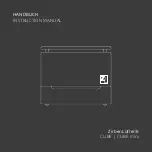
Thirty-six inches of Quad Twist lead wire are attached during the production process. If additional connection wire is required,
use the following instructions:
1. Prepare the sensor leads with a RMA (rosin mildly active) soldering flux, tin them with a minimal amount of solder. One
common solder that can be used to 500 K (227°C) is 90% Pb/10% Sn. Note that common 60% Sn/40% Pb or
63% Sn/37% Pb solder will melt at temperatures above ~165°C. Use a low wattage soldering iron that will not exceed
300 C. Clean off residual flux with rosin residue remover.
2. Strip the insulation from the connecting wires by delicately scraping with a razor blade, fine sand paper, or steel wool.
(Phosphor-bronze or Manganin wire, in sizes 32 or 36 AWG, is commonly used as the connecting lead wire. These wires
have low thermal conductivity which helps minimize the heat flow through the leads. For use to 500 K, polyimide or other
suitable insulation must be used on the lead extension wire. Follow the same procedure in step 1 for preparing connecting
wires.
3. Identify lead polarities and apply the soldering iron above the joint area until the solders melt; remove the iron
immediately. Leave enough slack to allow for the thermal contractions that occur during cooling which could fracture a
solder joint or lead. Insulating the soldering joint is recommended to prevent shorts. Use heat-shrink tubing rated to the
appropriate temperature to insulate the electrical joint.
HEAT SINKING/THERMAL ANCHORING
Depending on the application, sufficient heat sinking of the leads may already exist in the bobbin. Use the following procedure
if additional heat sinking is recommended. For additional heat sinking/thermal anchoring:
1. Connecting wires should be thermally anchored at several temperatures between room temperature and cryogenic
temperatures to guarantee that heat is not being conducted through the leads to the sensing element.
2. A simple thermal anchor can be made by winding the wires around a copper post, bobbin, or other thermal mass. A
minimum of five wraps around the thermal mass should provide sufficient thermal anchoring. However, if space permits,
additional wraps are recommended for good measure. To maintain good electrical isolation over many thermal cycles, it is
good practice to apply a single layer of heat sinking medium (e.g., high temperature epoxy or high temperature Stycast) to
the anchored area then wrap the wire around the paper and bond in place with an additional layer.
CRYOGENIC ACCESSORIES
– Recommended for proper installation and use of DT-470/471/670/671-CU-HT and
TG-120-CU-HT Sensors:
Apiezon
®
Type N and H Grease.
P/N GAN-25 and GAH-25
– 25 g tube. Low viscosity, easy to use, solidifies at cryogenic
temperatures, excellent lubricant. Difference is melting point: Type N is 316 K, Type H is 523 K.
Heat Sink Bobbins.
P/N HSB-40 Large, HSB-8 Small. Gold-plated copper bobbins. Large bobbin holds up to 40 wires, small
bobbin holds up to 8 wires, depending on wire gauge and number of turns.
High-Temperature Solder.
P/N SLT-10
– 3 m (10 ft). Greater lead content (90% Pb/10% Sn) for soldering in applications up
to 500 K.
Indium Foil/Solder.
P/N IF-5 for 5 foil sheets (2 in square × 0.005 in thick), ID-10-31/ID-10-56 for 10 disks, 0.31 in or 0.56 in
diameter × 0.005 in thick, respectively. Indium is 99.99% pure, exceptional pressure seal, extremely malleable. Melting point
is 429 K (156 °C).
Ostalloy
®
158 Solder.
P/N SOSY-16
– 16 oz. Reusable eutectic alloy with sharply defined melting point of 343.16 K (70 °C).
Stycast
®
Epoxy 2850FT, Catalyst 9.
P/N ES-2-20
– 20 packets, 2 g each. Permanent attachment, excellent low temperature
properties, poor electrical conductor, low cure shrinkage. Rated to 403 K (130 °C). [Requires hazardous shipping.]
VGE-7031 Varnish.
P/N VGE-7031
– 0.5 L (1 pt) can. Nonpermanent attachment, excellent thermal conductor, easy to apply
and remove. Rated to 423 K (150°C). [Requires hazardous shipping.]
Instruments:
Lake Shore sells a complete line of instrumentation used with your sensor, such as: current sources,
temperature controllers, monitors and thermometers, temperature scanners and transmitters.
Wire.
Lake Shore offers numerous types of wires for various applications, including phosphor-bronze wires: Single Strand,
Duo-
Twist™, Quad-Twist™, and Quad-Lead™, Nichrome heater wire, non-magnetic Manganin wire, and more. Use
unbonded, polyimide insulated wire for use to 500 K.
Cable.
Lake Shore offers ultra-miniature coaxial cable (Type C, SC, and SS), semi-rigid coaxial cable (Type SR), and a robust
4-wire Cr
yoCable™ (Type CYRC).
For complete product description and detailed specifications on the above accessories and instruments, consult the
Lake Shore Temperature Measurement and Control Catalog, call (614) 891-2243, e-mail at
, or visit our
website at
www.lakeshore.com
.
Form Number F025-09-00_E
©2015
25 May 2015




















